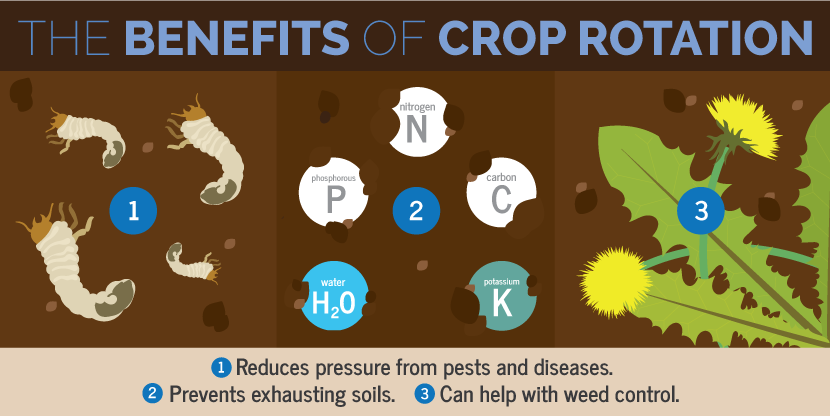The sight of large fields full of one type of crop ripening in the sun may now be a quintessential part of the countryside, but this mass-production method of cultivating a single species has long been known to cause problems.
Large groups of the same crop make an easy target for pests. For this reason, non-organic commercial growers feel compelled to spray the whole area with pesticides. Soil nutrients are depleted when the ground is occupied by a large number of the same type of plant. This problem is compounded if the ground is used for the same crop next season – often the soil becomes so impoverished that artificial fertilizers are needed. And soil subjected to the same mechanical processes year after year will inevitably become compacted.
While the gardener won’t be growing as intensively as the farmer, these problems may also be encountered on a smaller scale. You may see a drop in plant health and productivity if crops are grown in the same spot for many years.
To avoid these pitfalls, adopt a crop rotation plan. The principle is straightforward enough – the same vegetables should not be planted in the same place year after year. As a system of organic gardening, crop rotation has many advantages:
It lessens the need for pest control
You reduce the spread of soil-borne disease
It avoids nutrient depletion in the soil
Growing specific groups of vegetables on a different part of the vegetable plot each year helps to reduce a build-up of crop-specific pest and disease problems and it organises groups of crops according to their cultivation needs.
Combined with other organic methods, rotation offers an excellent defence against all kinds of pests and disease.
Suitable for…
Crop rotation is used in allotment plots and kitchen gardens for most annual vegetable crops. Perennial vegetables (such as rhubarb and asparagus) do not fit into the rotation. Certain annual crops such as cucurbits (courgettes, pumpkins, squashes, marrows and cucumbers), French and runner beans, salads (endive, lettuce and chicory) and sweetcorn can be grown wherever convenient, merely avoiding growing them too often in the same place.
Plan your crop rotation before the growing season starts, and mark out the plots on the ground so you know where to plant each crop.
Benefits of crop rotation
Soil fertility: Different crops have different nutrient requirements. Changing crops annually reduces the chance of particular soil deficiencies developing as the balance of nutrients removed from the soil tends to even out over time.
Weed control: Some crops, like potatoes and squashes, with dense foliage or large leaves, suppress weeds, thus reducing maintenance and weed problems in following crops.
Pest and disease control: Soil pests and diseases tend to attack specific plant families over and over again. By rotating crops between sites the pests tend to decline in the period when their host plants are absent which helps reduce build-up of damaging populations of spores, eggs and pests. Common diseases that can be helped avoided by rotation include clubroot in brassicas and onion white rot.
How to do crop rotation
Divide your vegetable garden or allotment into sections of equal size (depending on how much of each crop you want to grow), plus an extra section for perennial crops, such as rhubarb and asparagus.
Group your crops as below:
Brassicas: Brussels sprouts, cabbage, cauliflower, kale, kohl-rabi, oriental greens, radish, swede and turnips
Legumes: Peas, broad beans (French and runner beans suffer from fewer soil problems and can be grown wherever convenient)
Onions: Onion, garlic, shallot, leek
Potato family: Potato, tomato, (pepper and aubergine suffer from fewer problems and can be grown anywhere in the rotation)
Roots: Beetroot, carrot, celeriac, celery, Florence fennel, parsley, parsnip and all other root crops, except swedes and turnips, which are brassicas
Move each section of the plot a step forward every year so that, for example, brassicas follow legumes, onions and roots, legumes, onions and roots follow potatoes and potatoes follow brassicas. Here is a traditional three year rotation plan where potatoes and brassicas are important crops:
Year one
Section one: Potatoes
Section two: Legumes, onions and roots
Section three: Brassicas
Year two
Section one: Legumes, onions and roots
Section two: Brassicas
Section three: Potatoes
Year three
Section one: Brassicas
Section two: Potatoes
Section three: Legumes, onions and roots
How to do a four-year rotation
This is a four-year rotation for where potatoes and brassicas are not as important, but more legumes (which take up a lot of space) and onion-type crops are required:
Year one
Section one: Legumes
Section two: Brassicas
Section three: Potatoes
Section four: Onions and roots
Year two
Section one: Brassicas
Section two: Potatoes
Section three: Onions and roots
Section four: Legumes
Year three
Section one: Potatoes
Section two: Onions and roots
Section three: Legumes
Section four: Brassicas
Year four
Section one: Onions and roots
Section two: Legumes
Section three: Brassicas
Section four: Potatoes

